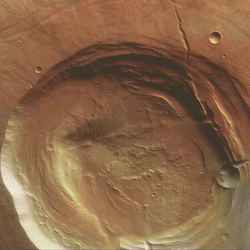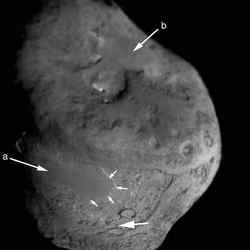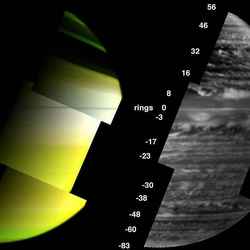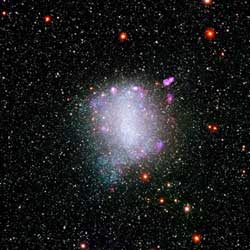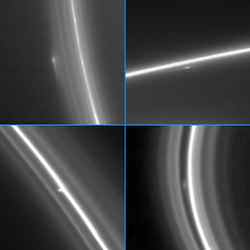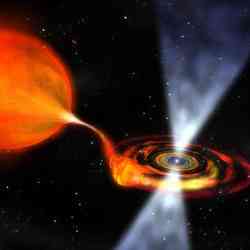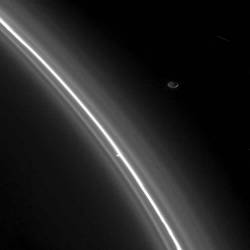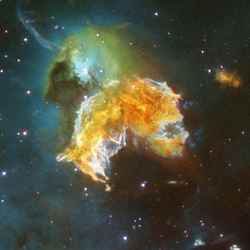
Supernova Remnant N 63A. Image credit: Hubble Click to enlarge
Life on Earth was made possible by the death of stars. Atoms like carbon and oxygen were expelled in the last few dying gasps of stars after their final supplies of hydrogen fuel were used up.
How this star-stuff came together to form life is still a mystery, but scientists know that certain atomic combinations were necessary. Water – two hydrogen atoms linked to one oxygen atom -was vital to the development of life on Earth, and so NASA missions now search for water on other worlds in the hopes of finding life elsewhere. Organic molecules built mostly of carbon atoms are also thought to be important, since all life on Earth is carbon-based.
The most popular theories of the origin of life say the necessary chemistry occurred at hydrothermal vents on the ocean floor or in some sunlit shallow pool. However, discoveries in the past few years have shown that many of the basic materials for life form in the cold depths of space, where life as we know it is not possible.
After dying stars belch out carbon, some of the carbon atoms combine with hydrogen to form polycyclic aromatic hydrocarbons (PAHs). PAHs — a kind of carbon soot similar to the scorched portions of burnt toast — are the most abundant organic compounds in space, and a primary ingredient of carbonaceous chondrite meteorites. Although PAHs aren’t found in living cells, they can be converted into quinones, molecules that are involved in cellular energy processes. For instance, quinones play an essential role in photosynthesis, helping plants turn light into chemical energy.
The transformation of PAHs occurs in interstellar clouds of ice and dust. After floating through space, PAH soot eventually condenses into these “dense molecular clouds.” The material in these clouds blocks out some but not all of the harsh radiation of space. The radiation that does filter through modifies the PAHs and other material in the clouds.
Infrared and radio telescope observations of the clouds have detected the PAHs, as well as fatty acids, simple sugars, faint amounts of the amino acid glycine, and over 100 other molecules, including water, carbon monoxide, ammonia, formaldehyde, and hydrogen cyanide.
The clouds have never been sampled directly — they’re too far away — so to confirm what is occurring chemically in the clouds, a research team led by Max Bernstein and Scott Sandford at the Astrochemistry Laboratory at NASA’s Ames Research Center set up experiments to mimic the cloud conditions.
In one experiment, a PAH/water mixture is vapor-deposited onto salt and then bombarded with ultraviolet (UV) radiation. This allows the researchers to observe how the basic PAH skeleton turns into quinones. Irradiating a frozen mixture of water, ammonia, hydrogen cyanide, and methanol (a precursor chemical to formaldehyde) generates the amino acids glycine, alanine and serine — the three most abundant amino acids in living systems.
Scientists have created primitive organic cell-like structures, or vesicles.
Because UV is not the only type of radiation in space, the researchers also have used a Van de Graaff generator to bombard the PAHs with mega-electron volt (MeV) protons, which have similar energies to cosmic rays. The MeV results for the PAHs were similar although not identical to the UV bombardment. A MeV study for the amino acids has not yet been conducted.
These experiments suggest that UV and other forms of radiation provide the energy needed to break apart chemical bonds in the low temperatures and pressures of the dense clouds. Because the atoms are still locked in ice, the molecules don’t fly apart, but instead recombine into more complex structures.
In another experiment led by Jason Dworkin, a frozen mixture of water, methanol, ammonia and carbon monoxide was subjected to UV radiation. This combination yielded organic material that formed bubbles when immersed in water. These bubbles are reminiscent of cell membranes that enclose and concentrate the chemistry of life, separating it from the outside world.
The bubbles produced in this experiment were between 10 to 40 micrometers, or about the size of red blood cells. Remarkably, the bubbles fluoresced, or glowed, when exposed to UV light. Absorbing UV and converting it into visible light in this way could provide energy to a primitive cell. If such bubbles played a role in the origin of life, the fluorescence could have been a precursor to photosynthesis.
Fluorescence also could act as sunscreen, diffusing any damage that otherwise would be inflicted by UV radiation. Such a protective function would have been vital for life on the early Earth, since the ozone layer, which blocks out the sun’s most destructive UV rays, did not form until after photosynthetic life began to produce oxygen.
From space clouds to the seeds of life
Dense molecular clouds in space eventually gravitationally collapse to form new stars. Some of the leftover dust later clumps together to form asteroids and comets, and some of these asteroids clump together to form planetary cores. On our planet, life then arose from whatever basic materials were at hand.
The large molecules necessary to build living cells are:
* Proteins
* Carbohydrates (sugars)
* Lipids (fats)
* Nucleic acids
Meteorites have been found to contain amino acids (the building blocks of proteins), sugars, fatty acids (the building blocks of lipids), and nucleic acid bases. The Murchison meteorite, for instance, contains chains of fatty acids, various types of sugars, all five nucleic acid bases, and more than 70 different amino acids (life uses 20 amino acids, only six of which are in the Murchison meteorite).
Because such carbonaceous meteorites are generally uniform in composition, they are thought to be representative of the initial dust cloud from which the sun and solar system were born. So it seems that nearly everything needed for life was available at the beginning, and meteorites and comets then make fresh deliveries of these materials to the planets over time.
If this is true, and if molecular dust clouds are chemically similar throughout the galaxy, then the ingredients for life should be widespread.
The downside of the abiotic production of the ingredients for life is that none of them can be used as “biomarkers,” indicators that life exists in a particular environment.
Max Bernstein points to the Alan Hills meteorite 84001 as an example of biomarkers that didn’t provide proof of life. In 1996, Dave McKay of NASA’s Johnson Space Center and his colleagues announced there were four possible biomarkers within this martian meteorite. ALH84001 had carbon globules containing PAHs, a mineral distribution suggestive of biological chemistry, magnetite crystals resembling those produced by bacteria, and bacteria-like shapes. While each alone was not thought to be evidence for life, the four in conjunction seemed compelling.
After the McKay announcement, subsequent studies found that each of these so-called biomarkers also could be produced by non-living means. Most scientists therefore are now inclined to believe that the meteorite does not contain fossilized alien life.
“As soon as they had the result, people went gunning for them because that’s the way it works,” says Bernstein. “Our chances of not making an error when we come up with a biomarker on Mars or on Europa will be much better if we’ve already done the equivalent of what those guys did after McKay, et al., published their article.”
Bernstein says that by simulating conditions on other planets, scientists can figure out what should be happening there chemically and geologically. Then, when we visit a planet, we can see how closely reality matches the predictions. If there’s anything on the planet that we didn’t expect to find, that could be an indication that life processes have altered the picture.
“What you have on Mars or on Europa is material that’s been delivered,” says Bernstein. “Plus, you have whatever has formed subsequently from whatever conditions are present. So (to look for life), you need to look at the molecules that are there, and keep in mind the chemistry that may have happened over time.”
Bernstein thinks chirality, or a molecule’s “handedness,” could be a biomarker on other worlds. Biological molecules often come in two forms that, while chemically identical, have opposite shapes: a “left-handed” one, and its mirror image, a “right-handed” one. A molecule’s handedness is due to how the atoms bond. While handedness is evenly dispersed throughout nature, in most cases living systems on Earth have left-handed amino acids and right-handed sugars. If molecules on other planets show a different preference in handedness, says Bernstein, that could be an indication of alien life.
“If you went to Mars or Europa and you saw a bias the same as ours, with sugars or amino acids having our chirality, then people would simply suspect it was contamination,” says Bernstein. “But if you saw an amino acid with a bias towards the right, or if you saw a sugar that had a bias towards the left — in other words, not our form — that would be really compelling.”
However, Bernstein notes that the chiral forms found in meteorites reflect what is seen on Earth: meteorites contain left-handed amino acids and right-handed sugars. If meteorites represent the template for life on Earth, then life elsewhere in the solar system also may reflect that same bias in handedness. Thus, something more than chirality may be needed for proof of life. Bernstein says that finding chains of molecules, “such as a couple of amino acids linked together,” also could be evidence for life, “because in meteorites we tend to just see single molecules.”
Original Source: NASA Astrobiology
![]()

